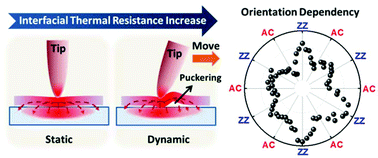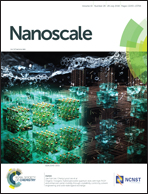Dynamic interfacial mechanical–thermal characteristics of atomically thin two-dimensional crystals†
Abstract
Owing to the flexible nanoelectronic applications of two-dimensional (2D) materials, further exploration of their nanoscale local mechanical properties and their coupled physical characteristics becomes extremely significant. The puckering effect is a typical micro/nanoscale local frictional characteristic generally in the tip–film–substrate system, which is simultaneously expected to be coupled with a dynamic thermal interfacial response. Here, applying scanning thermal microscopy (SThM), we observed a novel mechanical–thermal coupling effect in monolayer/bilayer MoS2 and WS2 films: puckering deformation can induce the enhancement of interfacial thermal resistance (TR). By the SThM method, the puckering effect was further proved to depend on the film thickness and the scan velocity. More importantly, the crystallographic orientation-dependent anisotropy of the puckering effect in atomically thin two-dimensional crystals was demonstrated by SThM. It is inferred that the puckering deformation of the film redistributes the in-plane stress, resulting in the isotropy breaking of the in-plane stiffness. Such new findings are of great significance to help optimize the nanoscale tribological/thermal design and dynamic mechanical–thermal management of 2D-materials in nanoelectronics.

- This article is part of the themed collection: Research selection from the NCNST


 Please wait while we load your content...
Please wait while we load your content...